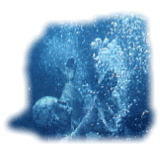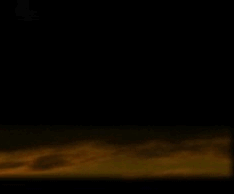|
Well, of the “Extract Of The Voyage” some is conjecture, and there are a couple of words I could not read– abbreviations, old French nautical terms and 250 year old idioms. Even a 19th century French-English dictionary did not help. But the point is made that the vessels were scouting the Antarctic ice flow. As the outsert of the map shows in the 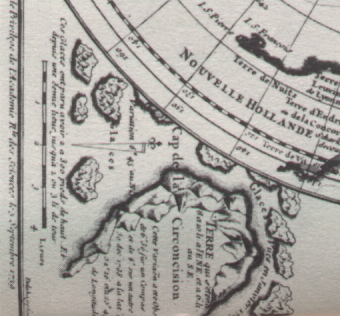 enlargement (right), they were sure land was seen, but they could not approach it due to the icebergs and frigid winds. enlargement (right), they were sure land was seen, but they could not approach it due to the icebergs and frigid winds.
The outsert on the Buache Map describing the Cape of Circoncision. It reads: “These iceburgs [glaciers] are from 2 to 300 feet high. And from one half league up to 2 or 3 leagues of circumphrance.”
This is not a map that Philippe Buache simply charted from old Greek maps that came from Atlanteans. These are nowhere mentioned. The map is a massive composite of deductions based on several explorer’s reports. Besides the routes of the Aigle and Marie, the chart holds courses described by Amerigo Vespuce (after whom America is named), and the route of Abel Tasman in 1642/3, some 100 years prior to this voyage. It is from all these reports of latitude and longitude that Philippe Buache designed the map.
Enlarging portions of the Buache Map helps us to see this. It is plain to see that New Zealand (Nouvelle Zelande) was considered attached to Antarctica. It had not yet been circumnavigated in Tasman’s time, and it is from Tasman’s 100 year old report that Buache was working. Buache had only Tasman’s report of his position when he entered the Bay of Assasins and the nearby Isle of the Three Kings, which he discovered in January 1643, as the map says. From this to the ice flow, Buache drew a line, presuming it was all land, thereby making a huge continent. New Zealand has not drifted 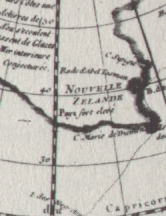 to its present spot. The map clearly marks its correct relationship to 30o SL and the Tropic of Capricorn. Because of this the coastline is very close to Terre de Deimen— Land of Demons, in other words, Tasmania. In several areas of “Antarctica” Buache placed Soupconnées and Conjecturée— suspected and conjectured. to its present spot. The map clearly marks its correct relationship to 30o SL and the Tropic of Capricorn. Because of this the coastline is very close to Terre de Deimen— Land of Demons, in other words, Tasmania. In several areas of “Antarctica” Buache placed Soupconnées and Conjecturée— suspected and conjectured.
Portion of the Buache Map showing New Zealand (Nouvelle Zelande) as attached to Antarctica.
It is shocking that anybody would claim the Buache Map is a copy of mysterious ancient Greek maps, which in turn were copied from Atlanteans or whomever. French is a common enough language to read and write. The map plainly declares its provenance as based on the “memories and the original map of Mr. Bouvet, who was in charge of the expedition.”
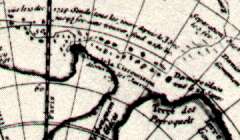 Ice, glaciers and freezing temperatures are repeating themes on the map. This is not Antarctica before the ice age. The Buache Map shows icebergs all over the area. Ice, glaciers and freezing temperatures are repeating themes on the map. This is not Antarctica before the ice age. The Buache Map shows icebergs all over the area.
The course of the frigates charted between the icebergs at Cap de la Circoncision. It reads “The view of 3 Dec, 1738; Sounded all the area from December 3 until February 4 without finding any bottom.” The line shows their course back to Cape of Good Hope, Africa.
The 18th century view was that icebergs originated from the run off of rivers into freezing bays. In order to account for so many of the size they saw, they deduced there must be a huge “Bassin terrestre” or inner harbor beyond the ice shelf into which the rivers must run. The icebergs would make their way out to sea via 2 large debouquements (outlets) of the Mer Glaciale (Glacial Sea), the name they dubbed this hypothetical bay. They believed Antarctica must have rivers “as considerable as those of Siberia which create the icebergs of the North.”
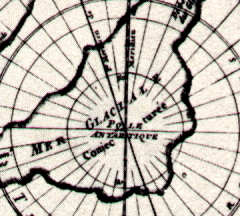
The imaginary MER GLACIALE. A Note on the chart suspected it was even bigger than this (the “inner harbor” of the rivers) in order to contain all the flow of the rivers which then froze creating the huge icebergs. The icebergs then drifted out of the Mer into the ocean by Cap de la Circoncision. This was suspected, while the above shape was merely conjecturée.
This strait that connects the Weddell and Ross seas is merely expressing that conjecture about iceberg creation. But the map plainly says the area is conjecturée. Today, we know there is a land bridge. However, from the extreme distance from which the readings had been taken (since the ships could not get close on account of all the surrounding ice) they merely assumed the vast sea of ice shelf attached over the horizon.
This “sea of ice” has its direction all fouled up as well, something a satellite photo would not show, nor a super civilization chart. It points toward Africa and Madagascar. This is certainly not what the much referred to 1958 geophysical year discovered in soundings. It is amazing this map has been touted as “exactly what Antarctica would look like if the covering ice were removed.”
|

